外国法制史第9章城市法与商法
- 格式:ppt
- 大小:847.00 KB
- 文档页数:32
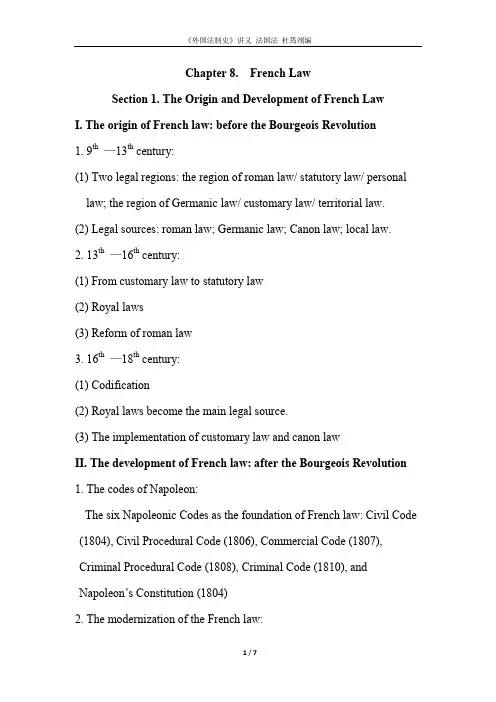
Chapter 8. French LawSection 1. The Origin and Development of French LawI. The origin of French law: before the Bourgeois Revolution1. 9th—13th century:(1) Two legal regions: the region of roman law/ statutory law/ personal law; the region of Germanic law/ customary law/ territorial law. (2) Legal sources: roman law; Germanic law; Canon law; local law.2. 13th—16th century:(1) From customary law to statutory law(2) Royal laws(3) Reform of roman law3. 16th—18th century:(1) Codification(2) Royal laws become the main legal source.(3) The implementation of customary law and canon lawII. The development of French law: after the Bourgeois Revolution 1. The codes of Napoleon:The six Napoleonic Codes as the foundation of French law: Civil Code (1804), Civil Procedural Code (1806), Commercial Code (1807), Criminal Procedural Code (1808), Criminal Code (1810), and Napoleon’s Constitution (1804)2. The modernization of the French law:The constitutional law, amendments of Civil Code, social law, and the EU lawSection 2. Constitutional and Administrative LawI. Fundamental principles of constitutional law1. The principle of separation of powers2. Statutes as the expression of the General Will (公意)3. The supremacy of the constitution: the rigid constitution4. Human rights:(1) Natural and positive right(2) Binding character(3) Rights against the state or through the state5. Forms of government(1) Forms of state(2) Forms of constitutional systemII. Declaration of the Rights of Man and of the Citizen (Déclaration des droits de l’homme et du citoyen, 人权宣言),17891. Structure: preamble; 17 Articles.2.Principles(1) Principle of human rights(2) Principle of sovereignty and separation of powers(3) Principle of Rule of LawIII. The Constitution of the Fifth Republic (第五共和国宪法), 1958 1. The legislative branch: Parliament(1) The Senate (参议院)(2) The National Assembly (国民议会)2. The executive branch: President(1) Constitutional powers: Art.5, 8-19, 49.(2) Presidential amnesties(3) The semi-presidential system: The executive powers are divided between president and prime minister.3. The judicial branch: Courts(1) Judicial courts(2) Administrative courts(3) Financial courts4. The Constitutional Council (le Conseil constitutionnel, 宪法委员会) (1) Membership9 members; one third of them are appointed every 3 years.3 members each are appointed by the president of the Republic, the president of the National Assembly, and the president of the Senate.The former presidents of the Republic sit in the council.The president of the Council is selected by the president of the Republic.(2) Powersa. The supervision of elections, both presidential and parliamentary and ensuring the legitimacy of referendums.b. The interpretation of the fundamental meanings of the constitution, procedure, legislation, and treaties.The Council can declare that a law is contrary to constitutional or treaty dispositions. The declaring renders the law invalid.IV. Administrative law1. Substantive law: the principle of legality(1) Constitution(2) Supranational norms(3) Statutes(4) General principles of law(5) Regulations2. The principle of liability(1) Tortious liability(2) Contract liability3. Procedural law(1) Administrative courtsAdministrative Tribunals; Courts of Appeal; Conseil d’Etat (国政院).(2) Judicial review: remedies and grounds for reliefLack of jurisdiction; procedural irregularity; violation of law; misuse of power.Section 3. Civil LawI. History of the French Civil Code (1804)The Napoleonic Code / Code Napoléon (拿破仑民法典)/ Code Civil des FrançaisThe French civil code was established under Napoléon I in 1804.The code forbade privileges based on birth, allowed freedom of religion, and specified that government jobs should go to the most qualified.It was drafted rapidly by a commission of four eminent jurists and entered into force on 21 March 1804. The Code, with its stress on clearly written and accessible law, was a major step in replacing the previous patchwork of feudal laws. Historian Robert Holtman regards it as one of the few documents that have influenced the whole world.II. StructureIII. Comparison to the German Civil Code (BGB)See the attachment.法国议会(立法机关)机构的历史变化:。
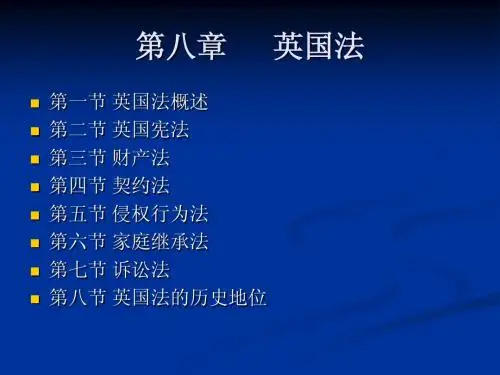
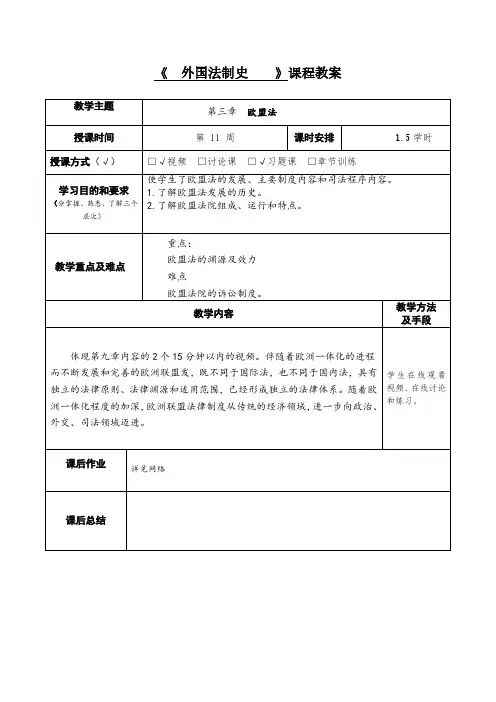
![第 9章 城市法和商法[15页]](https://uimg.taocdn.com/706fc54c2e3f5727a5e9625f.webp)
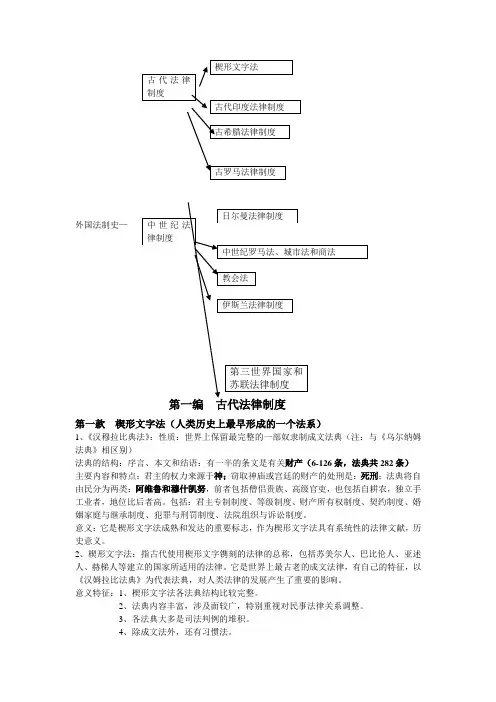
外国法制史—第一款楔形文字法(人类历史上最早形成的一个法系)1、《汉穆拉比典法》:性质:世界上保留最完整的一部奴隶制成文法典(注:与《乌尔纳姆法典》相区别)法典的结构:序言、本文和结语:有一半的条文是有关财产(6-126条,法典共282条)主要内容和特点:君主的权力来源于神;窃取神庙或宫廷的财产的处刑是:死刑;法典将自由民分为两类:阿维鲁和穆什凯努,前者包括僧侣贵族、高级官吏,也包括自耕农,独立手工业者,地位比后者高。
包括:君主专制制度、等级制度、财产所有权制度、契约制度、婚姻家庭与继承制度、犯罪与刑罚制度、法院组织与诉讼制度。
意义:它是楔形文字法成熟和发达的重要标志,作为楔形文字法具有系统性的法律文献,历史意义。
2、楔形文字法:指古代使用楔形文字镌刻的法律的总称,包括苏美尔人、巴比伦人、亚述人、赫梯人等建立的国家所适用的法律。
它是世界上最古老的成文法律,有自己的特征,以《汉姆拉比法典》为代表法典,对人类法律的发展产生了重要的影响。
意义特征:1、楔形文字法各法典结构比较完整。
2、法典内容丰富,涉及面较广,特别重视对民事法律关系调整。
3、各法典大多是司法判例的堆积。
4、除成文法外,还有习惯法。
5、楔形文字法是世俗法。
3、其他法典:乌尔第三王朝《乌尔纳姆法典》(目前所知历史上第一部成文法典)、《苏美尔法典》、《苏美尔亲属法》、《尼尼微法律教本》、《李必特·伊斯达法典》、《俾拉拉玛法典》第二款古代印度法律制度大约公元前3000年中叶,印度的土著居民达罗毗荼人创造了哈拉帕文化。
雅利安人入侵印度后,印度出现了最早的传世文献——吠陀。
吠陀是印度最古老而神圣的法律渊源,约成于公元前1500年至公元前600年,用诗歌体裁写成。
吠陀本集共4部:《梨俱吠陀》(赞颂明论)、《娑摩吠陀》(歌曲明论)、《耶柔吠陀》(祭祀明论)和《阿达婆吠陀》(巫术咒语汇集)。
由此产生了古印度最早的原始吠陀宗教---演变为婆罗门教。



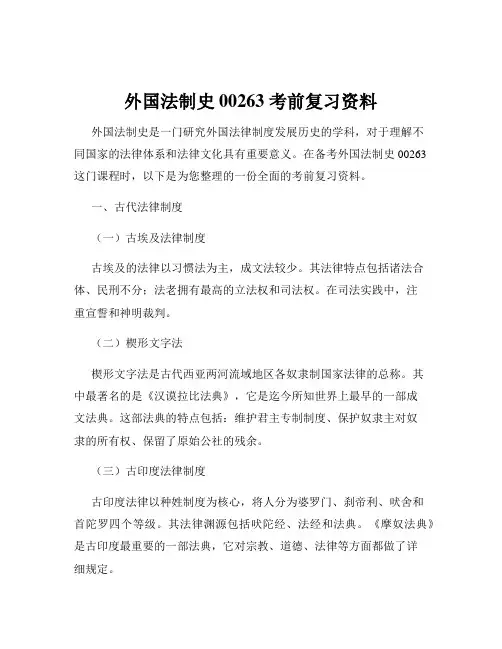
外国法制史00263 考前复习资料外国法制史是一门研究外国法律制度发展历史的学科,对于理解不同国家的法律体系和法律文化具有重要意义。
在备考外国法制史 00263 这门课程时,以下是为您整理的一份全面的考前复习资料。
一、古代法律制度(一)古埃及法律制度古埃及的法律以习惯法为主,成文法较少。
其法律特点包括诸法合体、民刑不分;法老拥有最高的立法权和司法权。
在司法实践中,注重宣誓和神明裁判。
(二)楔形文字法楔形文字法是古代西亚两河流域地区各奴隶制国家法律的总称。
其中最著名的是《汉谟拉比法典》,它是迄今所知世界上最早的一部成文法典。
这部法典的特点包括:维护君主专制制度、保护奴隶主对奴隶的所有权、保留了原始公社的残余。
(三)古印度法律制度古印度法律以种姓制度为核心,将人分为婆罗门、刹帝利、吠舍和首陀罗四个等级。
其法律渊源包括吠陀经、法经和法典。
《摩奴法典》是古印度最重要的一部法典,它对宗教、道德、法律等方面都做了详细规定。
(四)古希腊法律制度古希腊是西方文明的发源地之一,其法律制度对后世产生了深远影响。
雅典城邦的民主制度较为发达,法律注重公民的权利和参与。
斯巴达则以军事专制为特点,法律强调纪律和服从。
(五)古罗马法律制度古罗马法律制度经历了从习惯法到成文法、从公民法到万民法的发展过程。
《十二铜表法》是古罗马第一部成文法,标志着罗马法的诞生。
罗马法体系庞大,内容丰富,对后世法律制度的发展产生了极其重要的影响。
二、中世纪法律制度(一)日耳曼法日耳曼法是西欧早期封建时期适用于日耳曼人的法律。
其特点包括团体本位、属人主义、注重形式、缺乏抽象性。
(二)教会法教会法是基督教教会制定的法律。
它在中世纪的西欧具有重要地位,不仅调整宗教事务,还涉及到世俗生活的诸多方面。
(三)伊斯兰法伊斯兰法是适用于伊斯兰国家的法律,以《古兰经》和圣训为主要渊源。
其法律体系独特,对穆斯林的生活有着全面的规范。
(四)西欧中世纪的城市法和商法随着城市的兴起,城市法和商法逐渐形成。
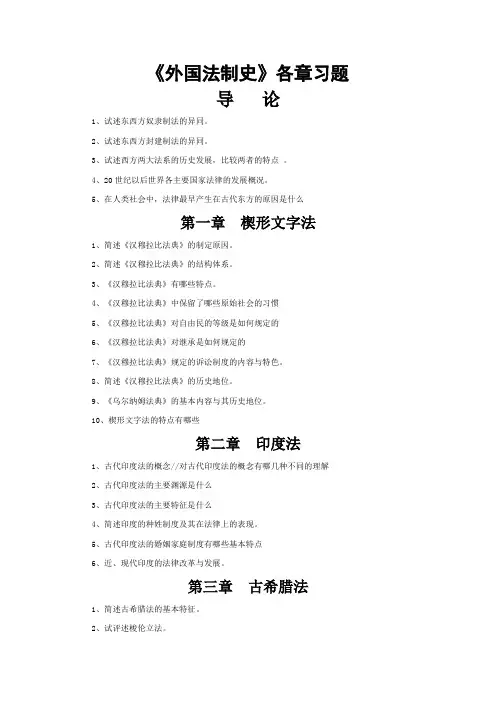
《外国法制史》各章习题导论1、试述东西方奴隶制法的异同。
2、试述东西方封建制法的异同。
3、试述西方两大法系的历史发展,比较两者的特点。
4、20世纪以后世界各主要国家法律的发展概况。
5、在人类社会中,法律最早产生在古代东方的原因是什么第一章楔形文字法1、简述《汉穆拉比法典》的制定原因。
2、简述《汉穆拉比法典》的结构体系。
3、《汉穆拉比法典》有哪些特点。
4、《汉穆拉比法典》中保留了哪些原始社会的习惯5、《汉穆拉比法典》对自由民的等级是如何规定的6、《汉穆拉比法典》对继承是如何规定的7、《汉穆拉比法典》规定的诉讼制度的内容与特色。
8、简述《汉穆拉比法典》的历史地位。
9、《乌尔纳姆法典》的基本内容与其历史地位。
10、楔形文字法的特点有哪些第二章印度法1、古代印度法的概念//对古代印度法的概念有哪几种不同的理解2、古代印度法的主要渊源是什么3、古代印度法的主要特征是什么4、简述印度的种姓制度及其在法律上的表现。
5、古代印度法的婚姻家庭制度有哪些基本特点6、近、现代印度的法律改革与发展。
第三章古希腊法1、简述古希腊法的基本特征。
2、试评述梭伦立法。
3、试评述雅典的民主制(表现及评价)4、什么是贝壳放逐法、不法申诉制度5、伯里克利进行了哪些民主制改革6、简述雅典的诉讼制度。
7、简述雅典的债法。
8、古希腊法和古东方法有什么差异9、古希腊为什么没有产生发达的法学第四章罗马法1、罗马法的概念。
2、试评述《十二表法》。
3、什么是市民法、万民法、自然法、裁判官法、公法、私法。
4、《国法大全》的结构。
5、简述罗马私法的体系。
6、简评罗马法的人格权制度。
7、评述罗马的法定诉讼、程式诉讼、特别诉讼。
8、罗马法上的债发生的原因有哪些9、评述罗马法学家的活动与历史贡献。
10、罗马法的特点是什么11、简述罗马法的历史地位及对后世立法的影响。
12、试述罗马法复兴的过程与历史意义。
第五章日耳曼法1、谈谈你所知道的蛮族法典2、蛮族法典有哪些特点3、日耳曼法的特点是什么4、简评日耳曼法的历史地位5、日耳曼王国时期日耳曼法和罗马法并存的原因是什么6、简述日耳曼人的婚姻制度。

外国法制史第一章导论一、外国法制史的研究对象和范围(一)研究对象研究对象分两个层次:①历史事实,包括事件、文件和制度;②发展规律,变化的基础、条件、原因和结果。
主要是后者,在这之上才能理解法制史,才能解释历史。
(二)范围1、内容范围(1)立法的历史(2)执法的历史(3)法的作用的历史(4)法的发展演变规律2、地域范围大陆法系;英美法系;伊斯兰法系3、时间范围大陆法系与普通法系的比较:1.含义:(1)大陆法系又叫民法法系、罗马法法系,是以罗马法为基础发展起来的以成文法为主要法律渊源的法律类型的统称。
(2)普通法系又叫英美法系,是指以英国中世纪的普通法为基础发展起来的以判例法为主要法律渊源的法律类型的统称。
2.范围:(1)大陆:法国、德国、葡萄牙、荷兰、非洲的埃塞俄比亚、南非、津巴布韦;日本、泰国、土耳其;加拿大的魁北克省,美国的路易斯安那州,苏格兰等。
(2)英美:除了英、美两国外,其他如印度、巴基斯坦、新加坡、缅甸、加拿大、澳大利亚、新西兰、马来西亚以及中国香港都属普通法系。
3.区别:(1)法律思维:演绎型思维;归纳式思维(2)法的渊源:法的正式渊源只是制定法;制定法、判例法都是法的正式渊源(3)法的分类:公法与私法;普通法与衡平法(4)诉讼程序:纠问制;对抗制(5)法典编纂:有代表性的法典;不倾向进行系统的法典编纂(6)法院体系、法律概念、法律适用技术、法律观念方面也不同大陆法系与英美法系的主要差异:第一,法律渊源不同。
大陆法系以成文法为主要法律渊源。
英美法系的法律渊源既包括各种制定法,也包括判例,而且,判例所构成的判例法在整个法律体系中占有非常重要的地位。
第二,法律结构不同。
大陆法系法典构成了法律体系结构的主干;英美法系很少制定法典,习惯用单行法的形式对某一类问题做专门的规定。
第三,法官的权限不同。
大陆法系法官只能适用法律而不能创造法律。
英美法系的法官不仅适用法律,也在一定的范围内在判例中运用法律解释和法律推理的技术创造法律。
外国法制史复习资料第一章楔形文字法(课本19页----29页)1.楔形文字法:古代两河流域及其毗连地区用楔形文字镌刻的法律的总称,往往又被称为楔形文字法系,在很长时期被许多国家采用。
它是人类历史上最早的一批成文法典,这些法典具有独特的体系结构的共同特征,其中,代表其发展最高水平的是<汉穆拉比法典>,其他还有<乌尔纳姆法典><苏美尔法典>等。
2.楔形文字法的特征A.是一部神定法B.结构体系较完整C.设计内容广泛D.采用不同法律判例的汇编和抽象概括3.乌尔纳姆法典:(公元前2113年至公元前2006年)的乌尔纳姆王创制,是迄今所知人类历史上最早的一部成文法典。
法典内容:A.禁止巫术B.伤害他人身体可用罚金代替刑罚C.把全体居民划分为自由民和奴隶D.缔结婚姻的当事人是男女双方家长E.妇女必须严守贞操,发现者处死4.阿维鲁:自由民按其社会法律地位的不同。
分为享有权利的自由民与不享有权利的自由民,前者称“阿维鲁”直译为“丈夫”,是具有公社社会资格的人,其中既有僧侣贵族,高级官吏,也包括自耕农和独立手工业者,法典有许多条纹专门保护他们的财产和人身安全。
5.神明裁判:在案件无法判别是否有罪的情况下,借助神明的意志判断诉讼当事人是否应负罪责,它在古代中世纪一些国家和地区被采用。
6. 德拉古法:公元前621年,奴隶主贵族德拉古将习惯法整理编纂,颁布了雅典第一部成文法,史称德拉古法。
该法主要提出三项改革:规定了公民权的取得条件;将官吏选拔由贵族会议决定改为公民抽签选举;组成一个由公民选举产生的四百零一人议事会。
德拉古法标志着雅典法进入了成文法时期。
7.<汉穆拉比法典>:该法典是古代楔形文字法律集大成的汇编,古巴比伦王国第六代国王汉穆拉比在位时制定,因此而得名。
是迄今已知保存最完整的古代早期法典,在楔形文字诸法典中具有代表性。
由序言,本文和结语三部分组成。
对古巴比伦以后的许多古代国家的法律有很大影响。
外国法制史复习材料1.名言翻译1)The life of law doesn't lie in logic, but in experience.(法律的生命不在于逻辑而在于经验)——《普通法》The law of fashion is the law of life.(法律透射时代的气息)——《科学中的法律与法律中的科学》2)上述两句名言代表了实用主义法学;它来源于美国的文化独立,抵制照搬美国,受达尔文的适者生存进化论的影响,即实用主义哲学思想在美国得到继承和发扬。
霍姆斯“实用主义法学”的演化发展:①受进化论的影响,霍姆斯认为应该以“实际效果”来检测美国对欧洲法律特别是英国法的继受,主张不能照搬英国法的判例,而应当以其能否适应美国的社会发展来删选,有用则继承,无用则摈弃。
由此创立了美国本土的“实用主义法学”。
(美国接受欧洲的法律进行立法,霍姆斯是“实用主义法学派”的奠基人,以实际效果来决定法律的作用,到底用不用英国的判例)②实用主义法学进一步发展为社会学法学,社会学法学以实用主义哲学和社会学作为其理论基础,并成为当代西方重要的法学流派。
社会学法学视法律为一种社会现象,强调法律和社会之间的关系,强调社会利益对法律和社会发展的重要性,强调法律、判决的社会效果。
(霍姆斯是“社会学法学派”鼻祖,后随社会的发展,“实用主义”法学派进步为“社会学法学派”,强调法律与社会的关系,主张法律要合适社会、促进社会发展,The law of fashion is the law of life.法律透射时代的气息)③自19世纪末到20世纪30年代,随着制度经济学家凡勃伦、康芒斯、科斯进一步强调法律与社会诸多要素中最重要的经济要素之间的互动,社会学法学进一步演化出经济分析法学,它与制度经济学相交融,注重从“交易成本”角度观察法律对经济的作用,从而对市场经济立法产生了深远的影响。
(霍姆斯是“经济分析法学派”鼻祖,“经济分析法学派”结合经济学“交易成本”概念,法律以最小的执法成本获取最好的法律效果)2、英国国会的形成历史及其影响1)形成历史:英王约翰被迫签署了宪法性的《大宪章》,王权被限制;约翰儿子亨利三世再次被迫接受“贵族请愿书”,即《牛津条约》,承认了议会独立于国王并定期开会的法定存在,从此英国国会正式形成。